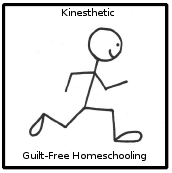Taking the Mystery Out of Learning Styles.
Kinesthetic comes from a Greek word that means to move, applying here to things that can be learned through movement. The tactile and kinesthetic learning styles have frequently been combined in other works, since touching and moving so often appear together in children’s behavior, but here we will focus on uniquely kinesthetic characteristics by themselves. Students labeled dyslexic most often fall under this learning style.
Your kinesthetic learner needs to move and engage his large muscle groups in order to learn best. He may not understand a lesson as well through reading the material himself or discussing it with you if his body is prohibited from moving at the same time. If your kinesthetic learner is stumped by a lesson, the problem may be that he is sitting down. He will benefit from the freedom to stand up, walk around freely, or take a running or stretching break before attempting the lesson again, as his large muscles provide a direct transmission line for moving information to his brain. Running and jumping and moving all around first will wake up his muscles and ready his mind for action.
Try these learning methods with your kinesthetic learner:
- Hands-on experiments and demonstrations
- Building projects and large construction toys
- Fraction blocks, Cuisenaire RodsTM, and all types of math manipulatives; consider using large books, toys, and other objects as math manipulatives
- Allow handwriting to be large:draw the letters in the air with the whole arm before trying it on paper
- Physical exercise gets the kinesthetic learner’s brain charged up and ready to learn. (“Run to the swing set and back five times as fast as you can, and then we’ll do your spelling.”)
- Allow him to get plenty of exercise before and allow him to wiggle and move around while you read aloud to him.
- Count by multiples (skip-counting) while doing jumping jacks or hopping on one foot or jumping up or down stairs to practice the multiplication tables.
If you, the teacher, are a kinesthetic learner, you will prefer any activity that takes you and your students out of the classroom, from field trips to nature walks. You will find role-playing, physical demonstrations, and dramatic re-enactments to be beneficial in presenting lesson concepts.
To reinforce and strengthen kinesthetic skills and improve eye-to-hand coordination in your students, try these methods:
- Build-it-yourself projects
- Woodworking and carpentry
- Large scale construction toy sets
- Hopscotch, jumping on a giant number line, or other physical movement for counting, adding & subtracting
- Sugar cubes as stackable math manipulatives for volume, area, multiplying & dividing
- Counting by multiples (skip-counting) along with swinging, jumping, or throwing, catching, or bouncing a ball
- Cuisenaire RodsTM
- Drawing or painting on large sheets of paper
- Threading beads onto leather shoe laces or fishing line to improve eye-to-hand coordination and fine motor skills
- Video or computer games
- Board & table games, such as Guess-turesTM or charades, that use acting or role-playing [Games can cover all learning styles: you see it, you hear it, you handle it.]
- CraniumTM games come in several varieties and exercise all learning styles
See also:
Kinesthetic Learning
Learning Styles
Auditory Learners
Tactile Learners
Visual Learners
Diagnostic Tools to Help the Homeschooling Parent also includes information on learning styles!

